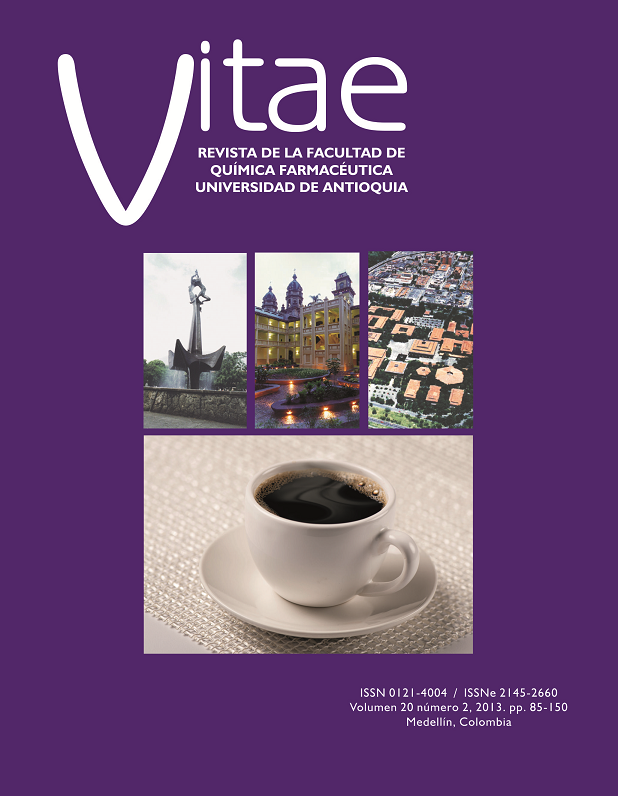The use of natural antioxidants (oregano and sage) to reduce hexanal production in precooked chicken during chill storage
DOI:
https://doi.org/10.17533/udea.vitae.13691Keywords:
Natural antioxidants, chicken meat, hexanal, oregano, sageAbstract
Background: The properties of plants with food preservation potential are well known since the antiquity. In recent years, the use of herbs and spices to improve the sensory characteristics and to extend the shelf-life of foods has been growing. Objectives: To compare oregano (Origanum vulgare L.) and sage (Salvia officinalis L.) as a natural antioxidant in balls of chicken breast and added 0.50% salt. Methods: Samples of chicken meatballs were pre-cooked for 8 minutes in a water bath at 80º C, and packaged in polyethylene bags with three layers, specific for vacuum cooking and high temperatures. The samples were separated into three groups: control (just salt), 0.10% oregano (dry plant) and sage 0.10% (dry plant), stored at -20º C for 144 hours. The tests to verify the formation of hexanal in samples were performed in the period of 0, 48, 96 and 144 hours of refrigerated storage. The determination of hexanal, extracted by micro-extraction (headspace solid phase micro-extraction - HS-SPME), was used as an indicator of the lipid oxidation of the samples. The analysis was conducted by a gas chromatograph coupled with a mass detector (GC-MS). The method was evaluated according to the validation parameters such as linearity, repeatability and detection limit. The extraction was conducted at 70º C using a fiber (DVD / CAR / PDMS) exposed for 20 minutes in the headspace after 5 minutes of equilibrium between the sample and the headspace. Results: Samples added 0.10% oregano or sage had effective protection in the development of hexanal, compared to control samples. The development of hexanal was significantly higher in the control samples, 34 μg of hexanal/100 g of sample at the beginning and 280 µg/100 g sample at the end of refrigerated storage. Conclusion: Herbs were effective in controlling the development of hexanal. However, the oregano was more effective than sage in preventing the formation of hexanal in chicken meatballs pre-cooked. The level of hexanal in herbs at the end of the storage period was 5 μg hexanal/100 g sample for oregano and 23 µg hexanal/100 g sample for sage.Downloads
Downloads
Published
How to Cite
Issue
Section
License
Copyright Notice and Open Access Statement
The Journal Vitae works under the Open Access license, and the published manuscripts remain available for the public, both on the Journal's website and in databases, under the Creative Commons license, "Noncommercial Attribution" and "Share alike" systems, adopted in Colombia. Hence, when the authors agree to publish in the Journal Vitae, they will not have the right to economic retributions on publications and reproductions through different diffusion media. The documents are freely available to the internet public, permitting users to read, download, copy, distribute, print, search, or link to the full texts and pass them as data to software. The only constraint on reproduction and distribution, should be to give authors control over the integrity of their work and the right to be appropriately acknowledged and cited.
Authors declare that:
-
They are the intellectual property owners and are responsible for all the information stated in the article.
-
This manuscript has not been submitted or published in other printed or digital media. They accept the responsibility for the judgments, opinions, and points of view expressed in the published article and, therefore, they exonerate Universidad de Antioquia and Journal Vitae from any process.
-
They exempt Universidad de Antioquia and Journal Vitae from settling conflicts or disputes related to the authorship of the referred article.
-
They accept the revision of the original manuscript by suitable personnel, and they bind themselves to perform the corrections appointed or suggested by the assessors.
-
Therefore, they know the editorial process and will not bind the Editorial Board of the Journal to assume any obligations regarding the volume and issue in which the article is published.
-
They transfer the rights of publication, reprinting, and distribution of the article from the moment of its approval, in print and digital format, without the right to economic rewards, and under the licensing conditions considered relevant by Journal Vitae.
-
They fully authorize Universidad de Antioquia and Journal Vitae to submit the published material to the diverse databases and indexing systems where the Journal can be found to comply with the requirements of the regulatory authorities to maintain the national classification of journals.
-
They will assume the article publication costs established for the current issue, and they will make the payment as soon as they are informed about the volume and the issue in which the final version of the article is published.
-
After the article is published, you can share digital or printed copies in a noncommercial manner. You will be able to use the paper in your institution or company for educational or research purposes, including the use in course programs.
Conflict of interest: Authors are responsible for recognizing and disclosing any financial or other benefits that could be perceived to bias their work, acknowledging all financial support and any personal connections with potential sponsors. Examples of such conflicts include receiving research funds or honoraria, serving on advisory boards, stock ownership, or employment and consulting arrangements. Authors without such connections should clearly state that they have no financial support or personal relationships that could be perceived to bias their work. All conflicts of interest should be disclosed on the author's identification page of the manuscript.










